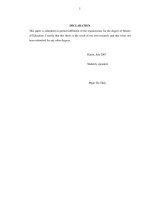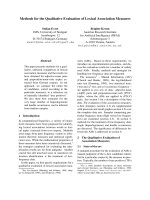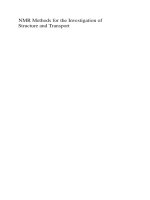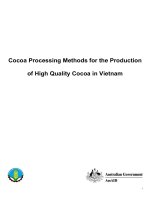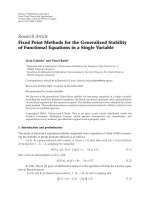Supplementary Information Comparison of three methods for the methylation of aliphatic and aromatic compounds
Bạn đang xem bản rút gọn của tài liệu. Xem và tải ngay bản đầy đủ của tài liệu tại đây (124.28 KB, 4 trang )
Supplementary Information
Comparison of three methods for the methylation of aliphatic and aromatic compounds
Hyejung Lee1*, Sarah J. Feakins1, Zhiyao Lu2, Arndt Schimmelmann3, Alex L. Sessions4, Jessica
E. Tierney5, Travis J. Williams2
1
Department of Earth Sciences, University of Southern California, Los Angeles, CA 90089, USA
2
Department of Chemistry, University of Southern California, Los Angeles, CA 90089, USA
3
Department of Geological Sciences, Indiana University, Bloomington, IN 47405-1405, USA
4
Division of Geological and Planetary Sciences, California Institute of Technology, Pasadena,
CA 91125, USA
5
Department of Geosciences, University of Arizona, Tucson, AZ 85721, USA
*Corresponding author:
Protocol for phthalic acid methylation
A. PURPOSE
This is a modification of a standard esterification procedure [1] to minimize isotopic
fractionation and optimize yield for phthalic acid methylation. Fatty acids are derivatized
prior to gas chromatography typically by the addition of a methyl group. The isotopic
composition of that added group must be known to calculate the isotopic composition of the
fatty acid. It has previously been suggested that phthalic acid presents a useful reagent for
determination of the isotopic composition of the added methyl group as phthalic acid is stable
for long term storage and shipment, and its isotopic composition can be independently
measured offline relative to the international reference standards [2]. In this way, the isotopic
composition of the methyl group in methanol can be readily determined in-house without
need for shipments and storage of a volatile compound. Here we report a recommended
method for the preparation of dimethyl phthalate yields for both carbon and hydrogen
isotopic analysis by gas chromatography flame ionization detection/isotope ratio mass
spectrometry (GC/FID/IRMS) using hydrochloric acid. Other common catalysts include
acetyl chloride and boron trifluoride (see text).
B. NECESSARY MATERIALS
1. Isotopically-determined phthalic acid
2. 5 wt% H2O deactivated silica gel
3. Solvents: ultra-pure water (Milli-Q or similar); dichloromethane (DCM) and hexane both
gas chromatography (GC) grade
4. Hydrochloric acid
5. Combusted borosilicate glass Pasteur pipettes and glass wool for plugging
6. Sodium sulfate (Na2SO4) anhydrous
7. Hot plate
8. 15-mL borosilicate glass culture tube and Teflon lined cap
9. Teflon tape
10. 40-mL borosilicate glass vial
11. 2-mL vial and Teflon-silicone-Teflon septum cap
12. N2 gas stream for evaporation.
C. PROCEDURE
1.
2.
3.
4.
5.
6.
7.
Weigh out 3 mg of phthalic acid and record the weight (for yield calculations).
Prepare 5 vol% HCl in methanol.
Put phthalic acid (1) and 1 mL of the mixture (2) to into a 15-mL culture tube.
Cap vial with Teflon lined cap and wrap Teflon tape around the cap to ensure a good seal.
Place in a hot block at 70 °C overnight.
At completion, check no loss of reagent (solvent level unchanged).
Turn off the hot plate and allow to cool. (Dimethyl phthalate will undergo ~ 0.3 ‰ 2Henrichment for every 12 hours, so should be promptly removed from the heat and acidic
solution, and processed after the overnight reaction.)
8. Perform liquid-liquid extraction and pass desired fraction through sodium sulfate column.
a. Add 1 mL of MilliQ water to dilute the reagent to enable separation.
b. Add 1 mL of DCM, and cap tightly.
c. Shake vigorously for 30 s.
d. Leave to settle, until two distinct density-separated layers form: the (upper)
aqueous layer and the (lower) DCM layer. (Note if using hexanes for fatty acid
extractions (b) hexanes will be the upper layer).
e. Extract the bottom layer (DCM) with a short pipette.
f. Load the extracted fraction onto a column containing Na2SO4 anhydrous. Collect
the eluent in a 40-mL vial.
g. Repeat steps b – f 3 to 5 times.
9. Silica gel.
a. Prepare a silica gel column and flush with DCM.
b. Load the fraction collected in 8f onto the silica gel column and elute with DCM.
10. Dry and transfer.
a. Evaporate the solvent from 9b under gentle N2 gas stream (without heating). Do
not dry completely to avoid evaporating dimethyl phthalate.
b. Transfer to a 2-mL GC vial with DCM.
c. Repeat a.
d. Add known volume of hexanes and analyze the dimethyl phthalate yield by
GC/FID and isotopic composition by GC/IRMS. Recap between measurements
and store Teflon taped in solvent.
D. ISOTOPE MASS BALANCE
1. Dimethyl phthalate ((C2H3O2)2C6H4)
a.
b.
2. n-Alkanoic acid (CnH2n-1O2)
a.
b.
E. ERROR PROPAGATION
1. GC/IRMS analytical uncertainties on an ester
The combined uncertainty on GC/IRMS δ2H determinations of an analyte, derivatized
as a methyl ester, is often ~5 ‰. As described in Polissar and D’Andrea [3],
propagated uncertainties include:
a. instrument precision for replicate measurements of the analyte,
b. the reference gas precision during sample and standard runs,
c. the uncertainty when comparing measured and known standard values, and
d. The uncertainty on the methyl group added during methylation (2).
2. Phthalic acid methyl ester chemical preparative uncertainties
The uncertainty on the methyl group added during methylation is often determined by
derivatizing a phthalic acid (known isotopic composition), a molecule presenting two
locations for methyl group additions, with an unknown methanol.
a. The uncertainty reported on Na-phthalate δ2H is 2.2 ‰ (1σ, n = 3).
b. The reproducibility (reaction chemistry uncertainty) when methylating phthalic
acid under normal, careful laboratory procedures is ~1 ‰ (1σ, n = 32). We
recommend that at least 3 reactions are performed to check preparative
reproducibility.
c. When reacting isotopically-known methanol and phthalic acid, we found the
calculated isotopic compositions of methyl hydrogen to be offset from that of the
known methanol value by 16 ‰ (n = 10; Figure 3). This inaccuracy points to an
isotope effect during the methylation reaction or an isotopic fractionation during
preparation.
i. We find negligible hydrogen isotope exchange under reaction conditions.
ii. We find yield to be only a problem for the non-acidic method; both acidic
methods have quantitative yields.
iii. Evaporation during the preparation or measurement may lead to 2Henrichment of ~10 ‰ in extreme user-error scenarios. This is avoidable
and can be monitored by quantification.
3. This study shows that the uncertainty on the methyl group added in methylation reactions
is underestimated when based on GC/IRMS instrument precision (1), Na-phthalate (2a)
and chemistry-reproducibility (2b). The largest source of uncertainty arises from
inaccuracy in determinations (2c) and we find this is not due to acidic exchange. We find
that phthalic acid is a particularly susceptible analyte due to its volatility. The key
implication is that evaporation should be minimized and analyte yields should be
monitored, especially for volatiles.
4. For the unknown analyte, the uncertainty in δ2H determination, introduced by the methyl
group uncertainty will vary by mass balance (D). For long-chain compounds, e.g. C28 nalkanoic acid (from plant leaf wax), the weight of methyl group is small such that the
combined, propagated errors are within 1 ‰ even if these of the methyl group using
dimethyl phthalate are as large as 18 ‰, as identified here. For shorter-chain compounds
such as C16 n-alkanoic acid (a lipid present in many organisms) propagated errors are
commensurately larger by 1 ‰ (Table 1).
F. REFERENCES
[1]
S. G. Wakeham, T. K. Pease, Lipid Analysis in Marine Particle and Sediment Samples. A
Laboratory handbook. Unpublished manuscript 1992.
[2]
A. L. Sessions, L. L. Jahnke, A. Schimmelmann, J. Hayes. Hydrogen isotope
fractionation in lipids of the methane-oxidizing bacterium Methylococcus capsulatus.
Geochim. Cosmochim. Acta 2002, 66, 3955.
[3]
P. J. Polissar, W. J. D’Andrea. Uncertainty in paleohydrologic reconstructions from
molecular δ2H values. Geochim. Cosmochim. Acta 2014, 129, 146.

